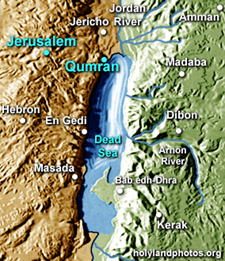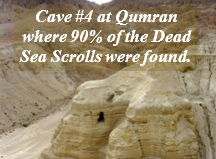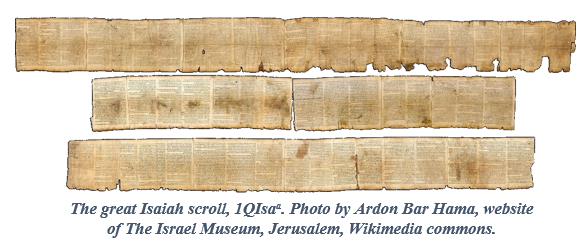75 years ago, in 1947 at Bethlehem, two Bedouin shepherds walked into Kando’s cobbler shop with four rolls of parchment in hand. Jum’a and Muhammed ed-Dib found 7 scrolls in a cave near the Dead Sea (pics below), stored inside tall ceramic jars (picture, bottom right).  Unaware of their true value, they sold the parchments to Kando, who was a cobbler and antiquities dealer. Although Kando couldn’t read the letters on the parchment, they resembled ancient Syriac writing he’d seen in Bethlehem’s Orthodox Church. He offered the scrolls to Archbishop Samuel, who purchased them for 24 Palestine pounds – about $100 at the time. In June 1954 all the scrolls appeared for sale through an ad in The Wall Street Journal, and Israel purchased them. [1]
Unaware of their true value, they sold the parchments to Kando, who was a cobbler and antiquities dealer. Although Kando couldn’t read the letters on the parchment, they resembled ancient Syriac writing he’d seen in Bethlehem’s Orthodox Church. He offered the scrolls to Archbishop Samuel, who purchased them for 24 Palestine pounds – about $100 at the time. In June 1954 all the scrolls appeared for sale through an ad in The Wall Street Journal, and Israel purchased them. [1]
 In total, the ‘Dead Sea Scrolls’, as they began to be called, are a collection of ~1,000 manuscripts, preserved in over 25,000 fragments. (The scrolls were broken up by other Bedouins whom archaeologists agreed to pay ‘by the square inch’ for any scrolls they found.) The texts include every book of the Hebrew Bible except possibly Esther, as well as unique sectarian writings. They were written between the 3rd century BC to 1st century AD. The scrolls pre-date all other known biblical writings (such as the Hebrew Masoretic Text and the Greek Septuagint) by at least 1,000 years. 40% are Hebrew scripts (e.g., the famous Isaiah scroll), 30% are non-canonical texts (e.g., the Book of Enoch), and 30% sectarian manuscripts (e.g., the Community Rule book). Most manuscripts were written in Hebrew, some Aramaic and Nabataean, and a few in Greek.
In total, the ‘Dead Sea Scrolls’, as they began to be called, are a collection of ~1,000 manuscripts, preserved in over 25,000 fragments. (The scrolls were broken up by other Bedouins whom archaeologists agreed to pay ‘by the square inch’ for any scrolls they found.) The texts include every book of the Hebrew Bible except possibly Esther, as well as unique sectarian writings. They were written between the 3rd century BC to 1st century AD. The scrolls pre-date all other known biblical writings (such as the Hebrew Masoretic Text and the Greek Septuagint) by at least 1,000 years. 40% are Hebrew scripts (e.g., the famous Isaiah scroll), 30% are non-canonical texts (e.g., the Book of Enoch), and 30% sectarian manuscripts (e.g., the Community Rule book). Most manuscripts were written in Hebrew, some Aramaic and Nabataean, and a few in Greek.

There is debate about the authors’ identity. Pliny the Elder (a geographer writing after the fall of Jerusalem in 70 AD) describes a group of Essenes, a Jewish sect, living in a desert community on the northwest shore of the Dead Sea near the ruined town of Ein Gedi. Most today connect the scrolls with that Essene community who lived at Qumran. The scrolls, then, would have been their library. The arid, remote environment around Qumran was well suited for the Essenes, who sought to remove themselves from society to live pure, righteous lives in accordance with a strict interpretation of Jewish law. We see from their writings that they anticipated eschatological events, the end of days. They believed that the promised Messiah would soon return, overthrow a corrupt society, and usher in the kingdom of God. [2]
Scholars find remarkable continuity between the scrolls and later copies, such as the Masoretic Text, even though the scroll is a textbook example of an inferior copy due to numerous scribal pens and overwrites. Gleason Archer wrote: “Even though the two copies of Isaiah discovered in Qumran Cave 1 near the Dead Sea in 1947 were a thousand years earlier than the oldest dated manuscript previously known (980 AD), they proved to be word-for-word identical with our standard Hebrew Bible in more than 95% of the text. The 5% variation consisted chiefly of obvious slips of the pen and variations in spelling.” [3] God’s faithfulness is well attested!
[2] https://www.biblicalarchaeology.org/daily/biblical-artifacts/dead-sea-scrolls/what_are_the_dead_sea_scrolls/
[3] Gleason Archer, A Survey of Old Testament Introduction (Chicago: Moody Press, 1994).
Like this? Consider sharing it to Facebook by clicking the linked icon below.
